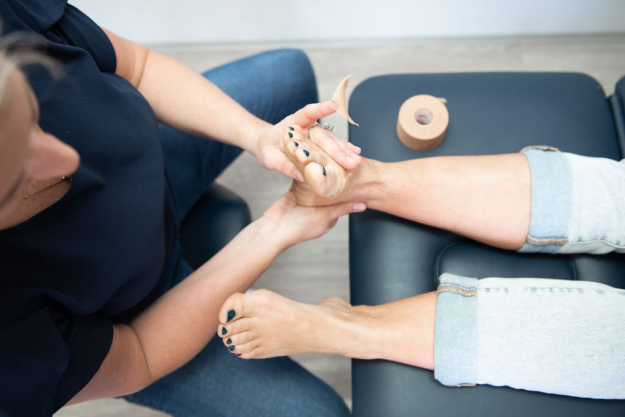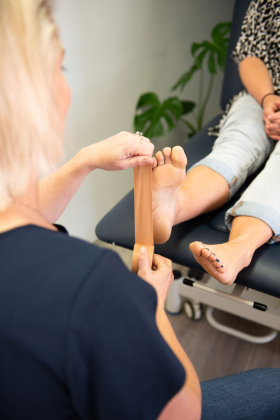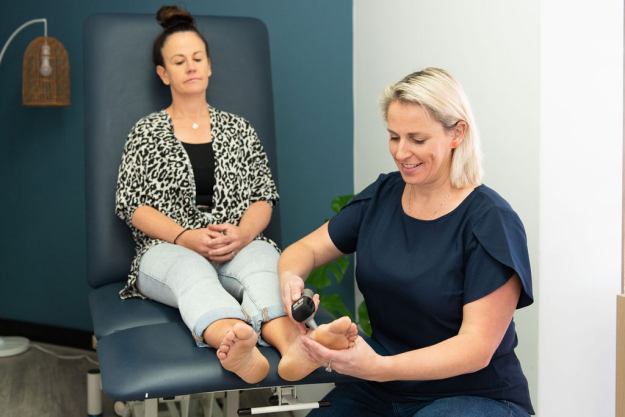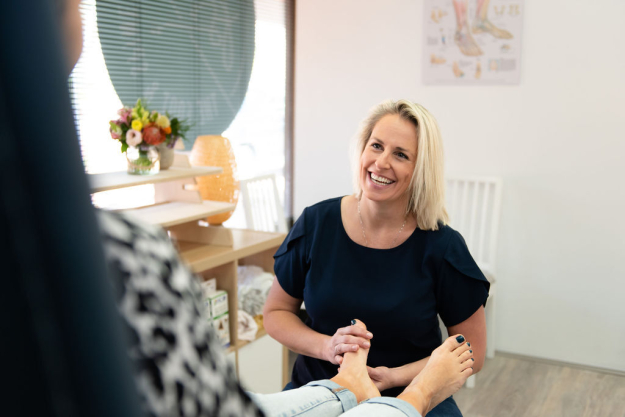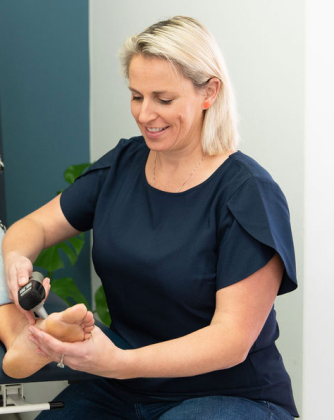
FREQUENTLY TREATED CONDITIONS
Bunions
A bunion is a painful, bony bump that forms on the joint at the base of the big toe. The condition is caused by the misalignment of the bone and the joint, resulting in the big toe leaning towards the other toes. This misalignment can cause the joint to become swollen and inflamed, leading to pain and discomfort.
Bunions can be caused by a number of factors, including genetics, ill-fitting shoes, and certain medical conditions such as rheumatoid arthritis. Women are more likely to develop bunions than men, and the condition is more common in older adults.
Treatment for bunions typically begins with conservative measures, such as myofascial therapy and low level laser therapy to improve the way the intrinsic foot muscles are working. It is also important to make sure properly fitted shoes are worn and orthotics can also be used to reduce the stress on the big toe joint. In severe cases, surgery may be necessary to correct the misalignment of the bones and the joint.
Plantar Fasciitis
Plantar fasciitis is a condition that causes pain and inflammation in the thick band of tissue that runs across the bottom of the foot. This tissue, known as the plantar fascia, connects the heel bone to the toes and helps to support the arch of the foot. When the plantar fascia becomes strained or inflamed, it can cause pain and discomfort in the heel and arch of the foot.
Plantar fasciitis is a common condition, among all ages. It is often caused by overuse of the foot, such as from excessive running or standing on hard surfaces for long periods of time.The structure and position of the foot will affect how much stress the plantar fascia is under.
At The Foot and Spine Co, we aim to improve the function of the foot, using myofascial therapy, low level laser therapy and stretches/exercises. We then look to reduce the excess movement of the foot, first through strapping then orthotics if they are deemed to be necessary. Footwear is also an important factor in treatment of plantar fasciitis.
Shin Splints
Shin splints is a common condition that causes pain and discomfort in the lower leg. It is typically caused by overuse of the muscles and tendons in the lower leg, and is often seen in athletes or individuals who engage in activities that put a lot of strain on the lower legs, such as running or jumping.
The symptoms of shin splints include pain and tenderness in the lower leg, along with swelling and stiffness. The pain is usually located along the inside or front of the lower leg, and is often worse when the individual engages in physical activity.
Treatment for shin splints typically with assessing why the muscles are being used so frequently. Using myofascial therapy/ low level laser therapy, we can reduce the tightness and inflammation of the shin muscles. Its also important to reduce the work of the muscles by controlling the movement of the foot with strapping/orthotics/correct footwear. Heat on the muscles prior to exercises and ice afterwards can also be helpful in managing pain. It is also important to avoid activities that put excessive strain on the lower legs, such as running on hard surfaces or engaging in high-impact activities without proper warm-up.
ACHY FEET
Achy feet is a condition that some people explain as a normal part of life but this is incorrect. Achiness in the muscles of the feet comes from overuse of the muscles and scar tissue formation. Myofascial therapy and low level laser therapy are very effective in the treatment of this condition.
ACHILLES TENDONITIS
This condition is an inflammatory condition involving the achilles tendon at the back of the heel. Often associated with “too much, too soon” training regimes, it is made worse with hill training, jumping and sprinting. Treatment of the calf muscle as well as the foot movement is necessary for pain relief.
OSTEOARTHRITIS OF THE KNEE/HIP/LOWER BACK
Osteoarthritis of the lower limb is often due to joint imbalance which means the joints move in the wrong plane and thus cause friction against the articular surfaces of the joints. This leads to uneven wear and tear/osteoarthritis and makes walking/standing etc difficult. As well as myofascial therapy around the area, altering the position of the feet is imperative to improving the symptoms of osteoarthritis.


